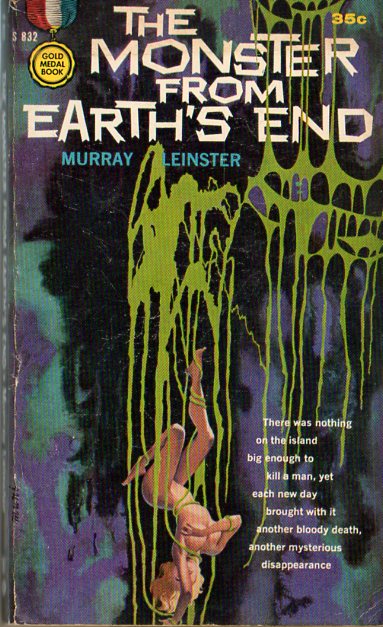"Mission To the Stars" by A.E. van Vogt (aka "The Mixed Men")
With an incredibly immersive and involved story, Van Vogt manages to use very
few words to imply so much about characters, the environment, and complex political situations. I was happily surprised at how few pages it took me to feel like I was “in” the story. And another happy surprise, a female main character, who is also in a position of power, along with a handful of other female officers! How wonderfully unexpected!
Grand Captain Lady Laurr Gloria Cecily commands the Earth ship Star Cluster on their ten year mapping mission of the Megallanic Cloud. As their mission comes to a close and they are readying for the interstellar trip home, they come across a lonesome weather station, manned by a suicidal meteorologist named Watcher. What is a weather station doing out in the middle of no where, where humanity has barely been, and why in the world did he kill himself after he had been given medical care on board the Star Cluster? Against the strong suggestions of the rest of the captains on the ship, Grand Captain Gloria Cecily decides to dive back into the Magellanic Cloud to search for possible colonists.
The government of Earth is a singular government, and does not tolerate any independent human colonies. Revolts are either put down, or the populations involved are killed. If there are human colonists living in the Magellanic Cloud, they will be absorbed into the government of Earth. But these people do not want to be found!
After the Grand Captain and her chief psychologist Nelsor take a guess at who these hidden people may be, the story splits, following Gloria Cecily in some chapters, and then switching to the point of view of Peter Malty, who is a “mixed man” living among the Dellians in the Cloud. It’s been nearly 15,000 years since the expulsion of the Dellian people from the galaxy. The Dellians followed a special kind of mind manipulation with the goals of intense intelligence, pure logic and unbelievably high IQs that caused many to be referred to robots, even though they were still human. Their “normal” human caretakes became known as the “non-Dellians”. In the rare event that a Dellian and non-Dellian were able to have a child, the result was a superbeing. Called the Mixed Men, these superbeings were capable of reading minds, and mentally manipulating others with ease.
Curiousity for the Mixed Men turned into fear, which quickly led to hatred, extermination and expulsion. The Dellians, non-Dellians, and secretive Mixed Men have been living in hiding in the Magellanic Cloud for the last 15,000 years. Perhaps in another fifteen thousand, the Mixed Men will be seen as equals by their own people. Until then, Maltby and his underground can only plan, and wait.
With his superbeing powers, Maltby allows his ship to be captured by the Star Cluster. His goal is to slowly take over the minds of the crew so he can learn about these humans, and destroy them if necessary. Once Chief psyhcologist Nelsor figures out his plan, she comes up with something so much more subtle.
See how quickly this gets complicated? And I haven’t even told you anything yet about the space weather and the technologies on board the ship, not to mention the politics of the Dellian culture and the dangers of the Mixed Men.
And yes, there is weather. The ship has entire departments of astrogators and meteorologists, analyzing and mapping storms. It’s someone what explained, but I believe the “Storms” they are trying to avoid are radiation and other waves that would blast out of supernovae? Again, not sure, and scientists probably had no idea at the time what “space weather” might have entailed, or not. The references to astrogators and meteorologists lent a deliciously nostalgic feeling to the whole story, like we were on a giant sea-going ship in the middle of an endless ocean, with only the night sky to guide the way.
Van Vogt couldn’t possibly have been the first science fiction author to come up with the idea of a “transporter”, but his definitely is the coolest. Called the “matter transmitter”, it breaks you down into your bits and pieces, send the bits and pieces to where you want to go, and then puts you back together again. Grand Captain Lady Laurr Gloria Cecily uses it all the time to get from one part of the ship to the another, because this ship is miles long (It kept bringing to mind the infamous line “The ship is too big. If I walk, the movie will be over”). But here’s the brilliant part, that I wish Star Trek had latched onto: because you are being scrambled back together again at the other side, who is to say you have to be put back together again exactly the way you were? These future humans use the Matter Transmitter as a medical device, fixing war wounds and injuries as they are transporting people. How brilliant is that?
The first two thirds or so of Mission to the Stars was absolutely incredible. Immersive, imaginative, innovative, I loved it and couldn’t put it down. The end of the story takes an incongruous direction and gets very strange and disconnected, proving this was indeed one of Van Vogt’s “fix-ups”, where he took a handful of short stories that followed the same characters and attempted to smush them into one coherent novel. But all in all, Mission to the Stars was a total winner, probably one of my better Vintage/golden age reads yet! (The Little Red Reviewer)



Comments
Post a Comment